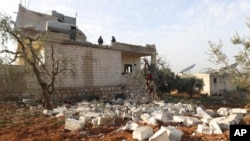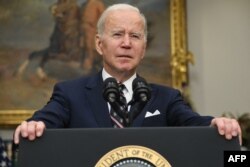Months after U.S. intelligence operatives tracked the leader of the Islamic State terror group to a non-descript residential building in northwest Syria, Amir Muhammad Sa'id Abdal-Rahman al-Mawla, detonated an explosive, killing himself and his family while U.S. forces closed in.
The account of the IS leader's death Thursday, from senior U.S. administration officials, came hours after reports of a major U.S. counterterrorism operation first began to emerge from Atmeh, a town in Syria's Idlib province, not far from the border with Turkey.
Accounts on social media described helicopters and U.S. forces descending on the three-story building as part of a hourslong operation, with some saying U.S. forces used loudspeakers to get civilians out of the building before an intense firefight erupted.
U.S. raid and civilian casualties
But the U.S. officials, speaking on condition of anonymity to discuss the operation in detail, said most of the death and destruction was caused by al-Mawla, also known as Abu Ibrahim al-Hashimi al-Qurashi and as Hajji 'Abdallah, and one of his lieutenants who also lived in the building, and were determined not to be taken alive.
"In a final act of cowardice and disregard for human life, Hajji 'Abdallah detonated a blast, a significant blast killing himself and several others, including his wife and children," one of the officials said during a call with reporters. "The blast was so large on the third floor that it blew bodies outside of the house and into the surrounding areas."
The IS lieutenant, U.S. officials said, then proceeded to barricade himself with his wife and family on the second floor and engaged U.S. forces before being killed.
U.S. officials said they could not confirm how many civilians were killed in the operation, emphasizing the IS leader appeared to have chosen to live in the residential building precisely because of the presence of civilians, including families with children.
Groups, like the British-based Syrian Observatory for Human Rights, said Thursday that at least 13 people had been killed, including three women and four children.
The U.S. officials said before the initial explosion — set off by al-Mawla — one family, including a mother, father and several children were able to escape. Another group of four children managed to escape following the death of al-Mawla's lieutenant.
The officials said, however, that all efforts to get other civilians out of the building were purposely hampered by the IS leaders.
"All casualties at the site were due to the acts of ISIS terrorists and inside the residents," the official said, using another acronym for the Islamic State group. "ISIS has been clear over and over again its utter and complete disregard for human life and that was clearly on display throughout the operation last night."
Biden remarks
U.S. President Joe Biden confirmed al-Mawla's death in a statement early Thursday, praising "the skill and bravery of our Armed Forces."
"Last night at my direction, U.S. military forces in northwest Syria successfully undertook a counterterrorism operation to protect the American people and our allies, and make the world a safer place," Biden said. "All Americans have returned safely from the operation."
Speaking later Thursday at the White House, Biden said the operation to take al-Mawla off the battlefield should send a strong message.
"This operation is testament to America's reach and capability to take out terrorist threats no matter where they try to hide," he said. "We will come after you and find you."
The U.S. president also praised the work of the U.S. intelligence community and the "essential partnership" of the U.S.-backed Syrian Democratic Forces, noting al-Mawla was directly involved in the planning of IS' recent weeklong assault on a prison in Hasaka, in northeastern Syria, in an attempt to free thousands of detained IS fighters.
U.S. officials said both Biden and Vice President Kamala Harris watched the operation unfold from the White House Situation room, keenly aware of the danger of trying to get the terror leader as he hid among civilians.
"It was an explicit decision to conduct a raid as opposed to a standoff strike of any sort," a second senior administration official said. "We had a good sense of who was in the building … and had taken numerous safeguards throughout the rehearsals and planning to protect those individuals."
The officials said planning for the operation began months earlier, with the president getting a final briefing in December that included a model of the area, highlighting the dangers involved, both for civilians and for U.S. forces who were going to be on the ground for about two hours.
They also said special forces even planned for the likelihood that al-Mawla would kill himself with an explosive device, studying the building to make sure a detonation would not bring it down.
"We had high confidence that if he did that as he did, that the building would remain structurally sound as it did," the first official said. "But I just want to emphasize, I doubt he knew that. And it was probably his intent to kill everybody in that building."
Officials said despite the success of the initial operation, there were some complications.
One of the helicopters used to get troops to al-Mawla's hideout experienced mechanical difficulties and had to be abandoned and destroyed shortly after leaving the site.
U.S. forces also briefly came under attack from fighters with the al-Qaida affiliated Hayat Tahrir al-Sham (HTS), killing two of them in the ensuing firefight.
Al-Mawla
Al-Mawla took control of IS in November 2019, shortly after U.S. special forces killed former leader Abu Bakr al-Baghdadi, also in a raid in northwestern Syria.
IS media officials quickly sought to build support for al-Mawla, posting a stream of photos and videos showing the terror groups various affiliates pledging allegiance to the new emir.
But unlike Baghdadi, who made rare but periodic appearances, al-Mawla was much more reclusive to evade the same fate as his predecessor.
One United Nations counterterrorism report last year noted, al-Mawla "remains reluctant to communicate directly with supporters."
Still, it is not entirely surprising U.S. forces tracked al-Mawla to northwestern Syria, which traditionally has been a hub for groups affiliated with al-Qaida, IS' main rival.
Western counterterrorism officials and U.N. member state intelligence agencies have long warned Idlib, in particular, "remains a strategic location for [IS] fighters and family members, in particular as a gateway to Turkey."
And in March 2020, the commander of U.S. Central Command, General Kenneth "Frank" McKenzie, said there are "remnants of ISIS" in Idlib "that do entertain attack plans against us."
Disrupting IS operations
The death of al-Mawla could be a pivotal blow to IS, which until now has proven to be resilient in the face of major setbacks.
"We anticipate that this is going to lead to disruption within ISIS," according to a senior administration official. "He's really one of the few remaining, shall we call them legacy leaders."
U.S. officials said that while al-Mawla sought to keep a low profile, he remained in control to run IS through a network of couriers, overseeing operations in Syria and Iraq, while also directing coordination with IS affiliates around the world, a role he played even under the group's previous leader.
U.S. intelligence official previously said al-Mawla had been a key architect of the Islamic State's slaughter of the Yazidi religious minority.
Al-Mawla's death also comes months after IS suffered a serious setback in Iraq.
This past October, Iraqi forces arrested Sami Jasim Muhammad al-Jaburi, also known as Hajji Hamid, described by the Pentagon as "one of ISIS's most senior leaders."
One Western counterterrorism official, speaking to VOA on the condition of anonymity to discuss intelligence, called al-Jaburi's arrest "very significant" as Al-Jaburi was seen as a candidate to potentially replace al-Mawla should he be killed or captured.















